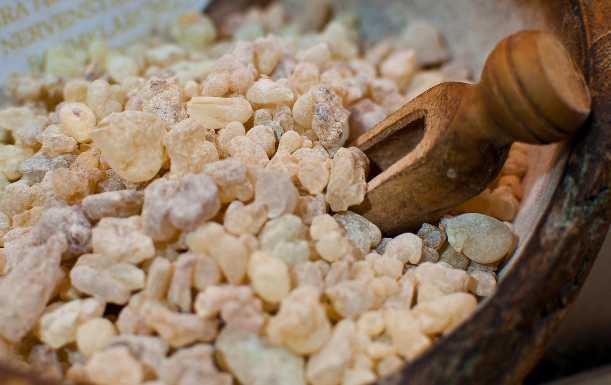
Frankincense - One of the most well regarded of the ancient incenses
by Sudhir Ahluwalia | Vigor Buddy |
One of the most well regarded of the ancient incenses, frankincense has a fresh pine-lemon scent with resinous and woody overtones that emanates from the milky white latex of the stem and branches. The name frankincense comes from the French words franc encens, which mean “pure incense” or “free lighting.” This name originates from the Frank Crusades of the 11th century, when the Franks were believed to store large quantities of frankincense for use as incense and medicine. In Arabic, it is called luban, which means “white” or “cream” and olibanum, which means “oil of Lebanon.” In Hebrew, it is called lebonah.
Frankincense resin is produced from multiple Boswellia species, the aromas of which vary. The resin is extracted by steam or carbon dioxide distillation. Boswellia sacra syn B. carterii has terpenic and pine flavor; Boswellia papyrifera is fruity and citrus with soft orange notes; Boswellia frereana has a pungent scent similar to cumin; Boswellia neglecta has a soft, earthy, and slightly musty aroma; Boswellia rivae is soft, woody, and elegant; and Boswellia serrata has fresh lemon, citrus, and pine notes. B. carterii, B. frereana, B. papyrifera, and B. serrata of the Burseraceae family are the major sources of frankincense.
- sacra, with its light lemony scent, is the most prized and is the species referred to most in the Bible. This tree grows today in Yemen and northern Somalia. Boswellia frereana and Boswellia thurifera, found in northern Somalia, are sources of the Coptic frankincense that is preferred by the Coptic Church. This too has a pleasant lemony scent and is also used in Arabian chewing gum.
- papyrifera is found in Kenya, Ethiopia, Eritrea, and Sudan in Africa. It has an orange scent and is used to produce the highest quantity of frankincense in the Afro-Arabian region. It is regarded as good for the stomach, though it can also cause stomach problems. B. serrata grows in the dry regions of India and yields an orange-scented gum that is lower quality than that of B. sacra. The gum is a popular ingredient in Ayurvedic medicine.
China imports the majority of frankincense produced in the world for use in traditional medicine. B. sacra-based frankincense was the major import to ancient China, perhaps because of China’s proximity to the Silk Route. Decreased production of B. sacra trees in Oman and northern Somalia caused a market share loss of this frankincense.
Multiple references to frankincense in the Bible indicate its importance. The King James Bible contains 113 references to incense and 17 references to frankincense. The Hebrew people blended frankincense with other precious resins like myrrh to make Ketoret, the perfume that was used to prepare the Jewish temple for worship. The three Magi brought gifts of gold, myrrh, frankincense, and spices to Baby Jesus.
As mentioned in Chapter 1, spices were often valued more than gold. Egyptian ladies used to prepare kohl from burnt frankincense and use that as eyeliner. Tradition has it that Queen Sheba brought frankincense saplings from Arabia for King Solomon. This high premium continued until the 19th century AD, when improved logistics, chemical alternatives, and increased supply led to decreased prices.
Frankincense was widely used by people in the Mesopotamian, Arabian, and Mediterranean regions. It has long been known to have inebriating, euphoric, and mood-enhancing effects. Some studies have confirmed the psychoactive and antidepressant effects of frankincense incense. The oil aids in treating skin ailments like acne and warts.
The Assyrians associated the incense with the goddess Ishtar and the gods Adonis and Bel (Ratsch, 1998, 92). Frankincense was a natural insecticide used by ancient Egyptians to fumigate wheat and grain stores and deter moths. In Arabia, they burned resin to keep mosquitoes and sand flies away. According to a reference in the Talmud, frankincense was given to intoxicate criminals before putting them to death.
Theophrastus, Dioscorides, and Pliny all mentioned the medicinal properties of frankincense. Dioscorides, the Roman military physician, used frankincense resin to treat soldiers’ wounds. He mentions the resin coming from the incense growing regions of Arabia, which are now in Yemen and Oman, and being adulterated with gum Arabic and pine resin. Avicenna, the Arabic physician of the 11th century AD, recommended frankincense to reduce fevers.
In Traditional Chinese Medicine, frankincense (ru xiang) has been used for centuries. The first reference to frankincense is in the Chinese medicine book Mingyi Bielu, or Miscellaneous Records of Famous Physicians (c. 500 AD). It is regarded to have a positive effect on qi. It invigorates the blood, dispels blood stasis, and it treats swelling, wounds, sore muscles, sores and boils, abdominal pain, dysmenorrhea, postpartum abdominal pain, and pain caused by trauma.
Just like other herbal medical formulations, frankincense is used in combination with other herbs. It is used in health care products such as cosmetics, soaps, perfumes, lotions, tooth paste, mouth washes, and medical ointments. It is also used in varnishes, adhesives, fumigation powders, pastilles, food flavors, chewing gum, and wound plasters. The aroma calms the nerves, enhances spirituality, and aids in meditation and prayer. However, the WHO has classified frankincense smoke as slightly hazardous.
—
Sudhir Ahluwalia is a business consultant. He has been management consulting head of Asia’s largest IT outsourcing company Tata Consultancy Services, business advisor to multiple companies, columnist and author of upcoming book on herbs-Holy Herbs. He has been a member of the Indian Forest Service. His webpage is: www.sudhirahluwalia.com

















